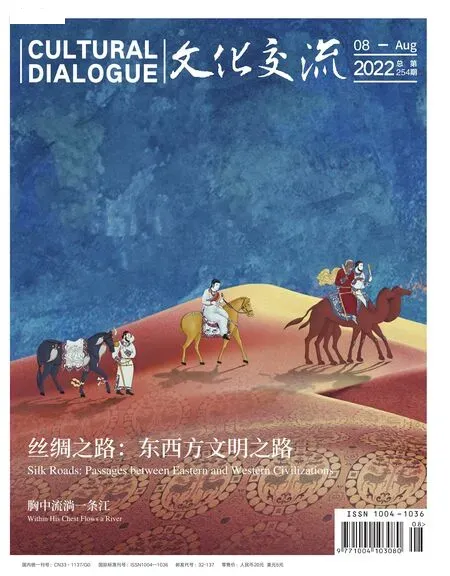王开明:用油画艺术展现最美牛腿
2022-08-26雷晓燕
文/ 雷晓燕

牛腿。The corbel, a classic joinery of ancient Chinese architecture.
如果人生可以分为上下半场,那么丽水人王开明在60岁之前,在人生的上半场,为了生计而奔波;在60岁之后,也就是人生的下半场,画丽水牛腿、推介丽水牛腿、保护丽水牛腿成了他的新使命。
牛腿,是中国古典建筑构件,专业术语叫撑拱,又叫雀替,是明清古建筑中上檐柱与横梁之间的撑木。在浙江古民居中,常可见到各式各样精美绝伦的牛腿。
被雕工细腻、题材丰富的牛腿所吸引,5年前,王开明迈开了他的牛腿人生路。去年5月,他的牛腿系列油画展开展,再现了处州(丽水古称处州)老宅风情和古民居乡土文化。一年多过去了,他还在为牛腿奔忙。“因为牛腿,我的人生更精彩。”今年65岁的王开明如是说。
跑百村只为发现最美牛腿
王开明自幼喜欢绘画,绘画爱好伴随着他的成长。虽然先后就读的是矿山机械和企业管理专业,貌似都与艺术失之交臂,但绘画在他学习、工作以及生活中起到了极其重要的作用,成为了生命中不可或缺的一部分。2017年4月,他去岳父的老家景宁沙湾镇东堡村祭祀。在村中闲逛时,一栋墙面倒塌、瓦片掉落的老房子里,他发现因为牛腿依然有力地支撑着,梁柱虽然有些倾斜,但却坚挺撑起廊檐,这栋老房子因此没有完全坍塌下来。
顿时,王开明对牛腿产生了兴趣。
回家后,他查找了许多资料。随着了解越来越深入,对牛腿的好奇、心动、喜欢和狂热,驱使他开始在丽水九县(市、区)寻找最美“牛腿”。
一辆小车、一台单反和一只平板电脑,就是他的装备。而做攻略的内容,就是从网上找到的几十个古村落和亲朋好友提供的线索。
5年寻“腿”路,有风雨,有失望,更有收获和感动。
王开明介绍,有的古村落,好不容易找到,却发现古村落遗址只剩下地基;有的古村落,按照导航驾驶,路都到尽头了,村子还不见踪影。
比起这些寻而不得的失望,淳朴善良的乡亲们让他忘记了所有的艰辛。
在莲都区大港头镇张山村,王开明寻到一个精美的牛腿。“那天是阴天,加上老屋光线不好,牛腿怎么也看不清、拍不清,急得团团转。”
老屋里的住户看到后,主动问他:台灯有用吗?得到试试的答案后,住户夫妻俩找来两三个接线板,妻子负责看管、按紧插头,丈夫负责奋力高举台灯,好让王开明看清、拍清自家牛腿的每一个细节。
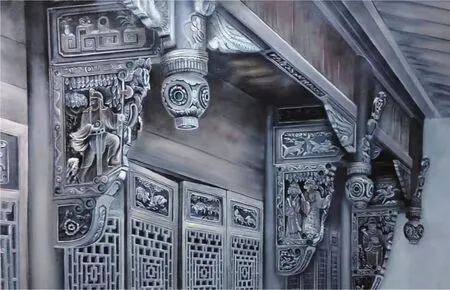
牛腿。The corbel, a classic joinery of ancient Chinese architecture.
5年寻“腿”路,王开明喝过百家茶、吃过百家饭。寻访结束,大爷大妈总是依依不舍地把他送到村口,握着他的手,叮嘱他有空再来走走看看。“丽水的乡亲,太令我感动了。”他感慨地说。
画牛腿独具一格
王开明一边寻找最美牛腿,一边整理资料,并以照片为基础进行创作。
5年来,他拍摄了3个移动硬盘的照片,牛腿多达上千个。但不是所有的牛腿,都能成为创作对象。他介绍,只有具备有独特造型、有独特寓意、有感人故事其中一个或一个以上标准的牛腿,才有可能被选中。所以,东堡村的牛腿,虽然造型简单,却成为88幅油画中的首幅。
王开明坦言,他不是画家,只是名绘画爱好者。如何用最完美的画技,展现精美绝妙的牛腿之美?
他经过思考,决定把牛腿当作舞台上的主角,当光束打在主角上,那么,主角一定是最突出、最显眼的。
那么,梁柱交错间,如何让画面立体、构图严谨?
王开明说,他采用的是平面制图设计和绘画透视的融合方式,有效地利用了建筑结构本身所形成的几何图形轮廓,使线条错落有致,画面呈现出立体感。
现实中,很多牛腿遭到损毁。有一个牛腿,雕刻了多个人物,但所有人物的头部都不见了。他了解牛腿所处年代建筑的风格和特色后,走访住户,查找资料,通过合理的想象将其补齐,尝试着让它变得完美如初,在画面上不留遗憾。
有的古民居灰暗破败,他选择给牛腿打上光的同时,也顺便美化一番画面。比如,给柱子“贴”上红对联,给梁柱间挂上红灯笼或彩带—也许,这才是他心目中古民居的最美模样。
为了这88幅油画,王开明付出了很多。埋头创作的日子里,每天上午9时,他开始创作,午饭后午休一个多小时,接着画到凌晨。“晚上9时到凌晨3时,是创作的黄金时间,没人打扰,效率极高。”王开明介绍说。
守护“木头的史书”
5年的寻“腿”路,让王开明这个北方人兼丽水女婿,彻底爱上了丽水的乡土文化。
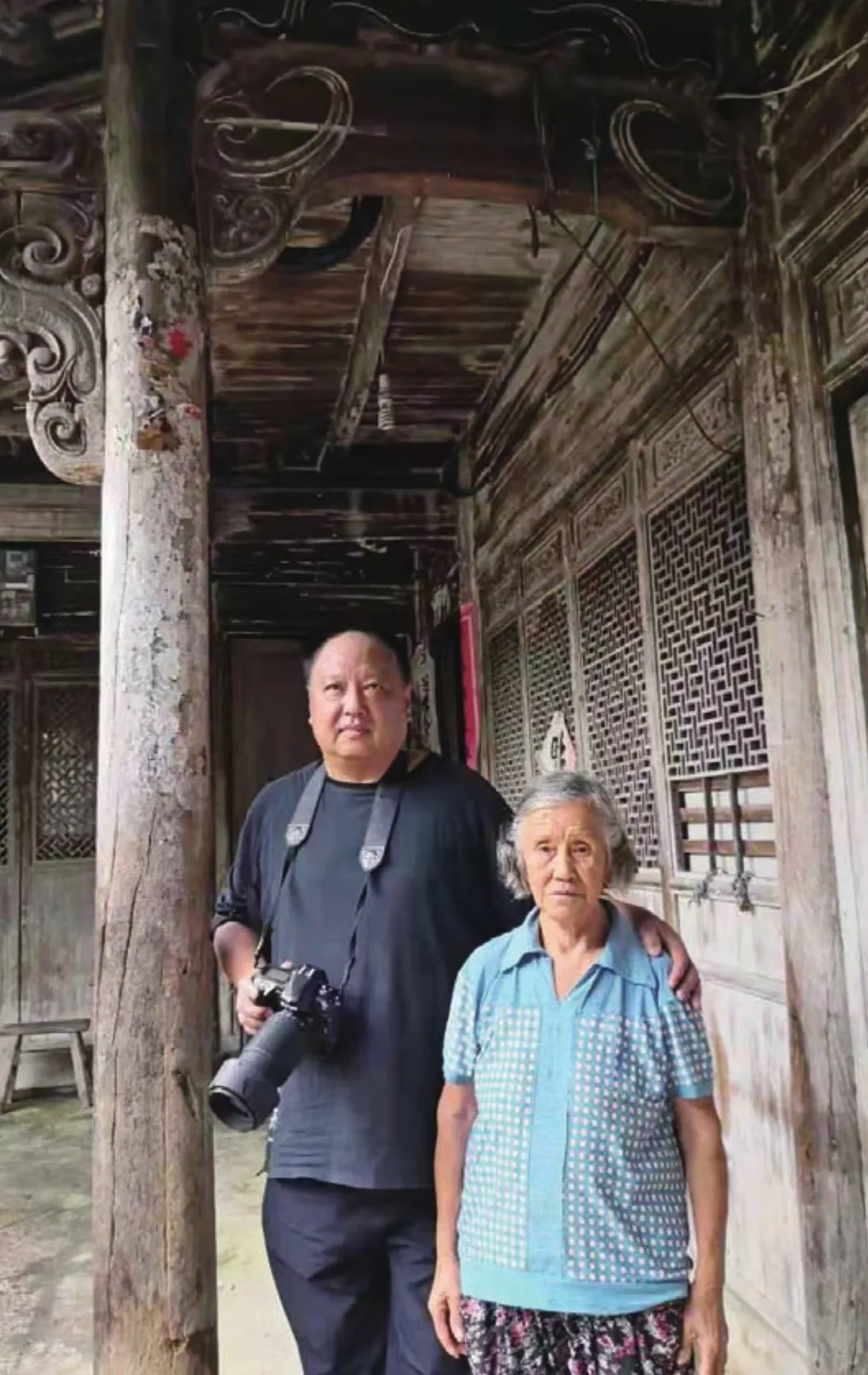
王开明在采风途中,与居民合影。Wang Kaiming takes a photo with a local resident during one of his field trips.
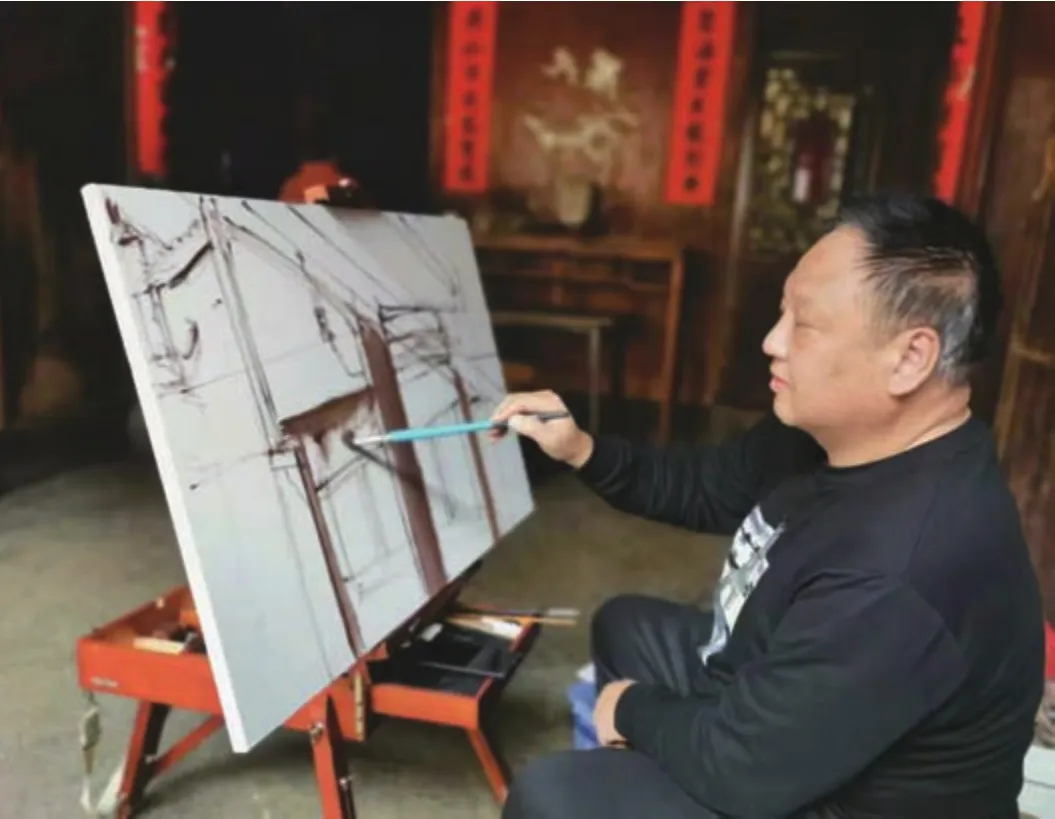
王开明在作画。Wang Kaiming works on a painting.
他说,作为丽水女婿,爱屋及乌,爱上了丽水这块热土,爱上了这里的乡土文化。通过了解古民居建筑装饰,通过画牛腿,让他看到了丽水这个古老城市的灵魂和生生不息的动力。“这次画展,目的之一,就是将丽水这位可亲可爱、可尊可敬的‘丈母娘’那博大胸襟里一颗颗璀璨的明珠穿缀成链后,展示给世人。”
在王开明的眼里,牛腿就是一部“木头的史书”,通过它,可以折射出不同历史时期、不同地理区域、不同民俗习惯和不同的文化心理等。
古往今来,健康长寿、富足平安和子嗣繁盛等,一直是人们的追求和目标。这些文化心理,通过图案组合,大量使用谐音、暗喻、象征等手法,在牛腿上得到了淋漓尽致的体现。如蝙蝠,寓意“福”;花瓶,谐音“平安”。而白头鸟和牡丹花,寓意“白头富贵”;在骏马上雕刻一只猴子,谐音“马上封侯”……
寄托了人们美好情怀和愿望的牛腿,同样得到了市民的喜爱,引发了乡愁和很多美好回忆。
2021年5月,《画说处州古宅风情 绘染牛腿民俗神韵》牛腿油画展在丽水美术馆开展。用王开明的话说,“实现了一次当代人与先辈能工巧匠的时空对话”。
在莲都区谭宅牛腿油画前,一名70多岁的女士流连忘返,久久不肯离去。王开明见状,上前询问,原来她是位退休老师,她说她出生在这座老宅,少年时期在这屋檐下度过。问她是否还记得这牛腿,她说:“记得,比我记忆中的漂亮……”
“问她有何感想,对方却摆摆手,没有多说什么,接着久久凝视着那幅牛腿画作陷入沉思。也许是她在回味老屋炊烟的味道吧,也许是她再次聆听到了母亲摇篮曲的吟唱吧。”王开明介绍说。
来自松阳的周火亮也来到了油画展。看着自家的牛腿变成了画,他激动地说,“我从小看着牛腿长大。今天,看到牛腿变成了油画,让更多人了解到我们丽水原来有这么多宝贝。高兴!”
随着时间推移,王开明的牛腿情结越来越浓烈。眼下,他正在为牛腿做三件事:一是申报2022年度丽水市文艺精品和文艺人才扶持奖励项目;二是将所绘105幅牛腿油画结集成册、出版;三是在积极对接,希望在浙江省内实现巡展,希望引发更多人对牛腿这个“木头的史书”的兴趣、了解和喜爱,希望社会各界加强对牛腿的保护、修缮和挖掘,弘扬工匠精神和牛腿文化。
Painting the Beauty of Corbels
By Lei Xiaoyan
If life could be divided into halves, then Wang Kaiming was busy making a living before the age of 60 while after 60, he began to paint, promote and protect corbels in Lishui city.
The corbel, a classic joinery of ancient Chinese architecture, is a support wood between the upper eave column and the crossbeam in the buildings of the Ming (1368-1644) and Qing (1616-1944) dynasties. Different kinds of exquisite corbels are common in Zhejiang’s ancient vernacular dwellings. Attracted by the fine carving and rich styles of corbels five years ago, last May, Wang held an oil painting exhibition featuring corbels and representing the folk customs and culture of ancient houses in Lishui. “Corbels add color to my life,” said the 65-year-old painter.
Wang has been into painting since he was a young boy. In April 2017, he went to his wife’s hometown to offer sacrifices to her ancestors. Wandering around the village, he found an ancient house whose walls collapsed with tiles falling down. However, the beam-columns, though inclined, were able to support the eaves firmly with the help of corbels, so that the house still stood there,which aroused his interest in corbels.
After that, he searched for information and gained a deeper understanding of corbels. His curiosity and obsession for corbels led him to discover the most beautiful corbels in Lishui, guided by online information and his relatives and friends.
During these five years, Wang experienced disappointment,harvests and excitement. He said that some ancient villages retained nothing but the foundations, while others were nowhere to be found even though he came to the end of the road. Despite those disappointments, the kindness of villagers made all the hardships worthwhile.
In Zhangshan village, Wang found an exquisite corbel. “It was an overcast day, and too dim for me to see it clearly inside the house, so I was very anxious.” Seeing this, the host asked if he needed a desk lamp. When Wang said they could have a try, the hospitable couple brought the lamp, and held it as high as possible,so that every detail of the corbel could be photographed well.
All these years, Wang Kaiming was entertained by many villagers with tea and meals. Before he finished a visit, the elderly villagers always saw him off reluctantly, telling him repeatedly to come back when he had time. “I’m so touched by the villagers in Lishui,” said Wang with gratefulness.
While searching for the most beautiful corbels, Wang Kaiming put the materials in order and drew from his photos. He had taken photos of a thousand corbels and stored them in three mobile hard disks. But only those corbels with unique shapes,special meanings or touching stories could be chosen. And his first work among 88 paintings was a simple corbel at Dongbao village.
Wang Kaiming said frankly that he was no artist, but a painting enthusiast. So how could he execute the perfect painting techniques to demonstrate the beauty of exquisite corbels? After a long deliberation, he decided to regard the corbels as the protagonists on the stage, because they would definitely become the star attraction when light shone on them. Another difficulty was how to make the pictures three-dimensional, with a careful composition to present the complicated interlocks between beams and columns.
Wang Kaiming adopted the integration of graphic design and perspective, using the geometric outlines of the building structure to show well-spaced lines, so that the painting appeared three dimensional. Many corbels had been damaged. There was a corbel with several headless carved figures. After determining the style and features of the house in the specific era, he visited the villagers,consulted books and completed the work with imagination,hoping to make it as if it was just carved.
Some ancient dwellings were gray and dilapidated. When he added lighting effects on the corbel, he was able to beautify the whole painting. For example, red couplets were “pasted” on the columns, and red lanterns or colorful ribbons were hung between the beams and columns, which might be the most beautiful sight of ancient vernacular dwellings in his mind.
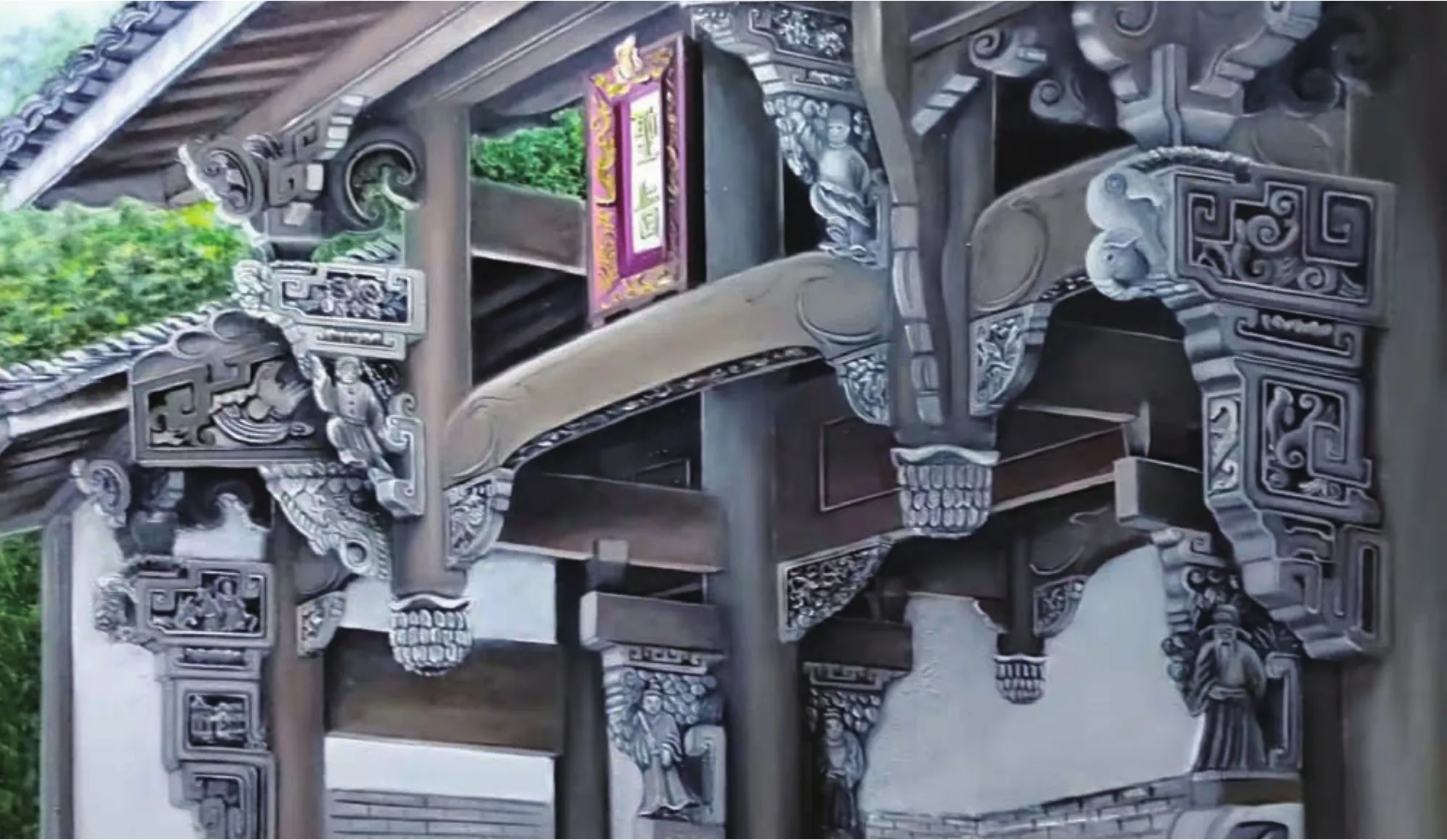
牛腿。The corbel, a classic joinery of ancient Chinese architecture.
Wang Kaiming exerted himself into these 88 oil paintings. In those days, he began at 9 o’clock every morning, took a nap after lunch, and then continued till the small hours. He said, “From 9 p.m. to 3 a.m., it was the golden time for painting. No one intruded, so I was highly efficient.”
During years of corbel searching, Wang Kaiming, a northerner and a son-in-law here, completely fell in love with Lishui’s folk culture. Through understanding the architectural decoration and painting corbels, he experienced the spirit and endless vitality of Lishui. “One of the purposes of this exhibition is to show the beauty of my second hometown to the world by stringing those bright pearls together,” he said.
For Wang Kaiming, the corbels are wooden history books reflecting different historical periods, geographical regions, folk customs and cultural psychology. Since ancient times, people have always pursued wellness, longevity, prosperity, peace and incessant offspring. This cultural psychology is vividly reflected on the corbels by combining patterns of paronomasias, metaphors, and symbols.For example, bats imply “happiness”; vases are homophonic with“peace” in Chinese; bulbuls and peony flowers mean “living together till old and grey”; a monkey carved on the horse is pronounced as“being granted with the title of marquis soon” in Chinese.
Corbels are also a favorite of citizens, evoking their nostalgia and good memories. In May 2021, Wang Kaiming’s solo art exhibition of corbels was held in Lishui Art Museum. According to him, “It opened a dialogue between modern people and our ancient artisans.” In front of a painting of the corbel from the Tans’house, stood a 70-year-old lady, who was lingering intoxicated. She said that she was born and bred in this ancient house. Wang asked if she still remembered the corbel, she replied, “Of course, but it’s more beautiful than I remember”. When asked how she felt, she shook her head silently, deep in meditation. Wang said, “Maybe she was savoring the smoke from the kitchen, or her mother’s lullaby.” Looking at a painting, Zhou Huoliang from Songyang county said excitedly, “I grew up with this corbel. Seeing it appear in the painting, I am so happy that more people can get to know these treasures in Lishui!”
As time goes by, Wang Kaiming’s love for corbels is getting intensified. At present, he is working on three things. First, he will apply for the 2022 Project for Awarding Literary and Artistic Works and Talents in Lishui. Second, he intends to publish a book of his 105 corbel paintings, and third, he wants to hold an exhibition tour in Zhejiang, hoping to arouse more interest,understanding and love for corbels. Meanwhile, he called for all sectors of society to attach greater importance to the protection,repair and discovery of corbels so as to promote the spirit of craftsmanship and corbel culture.
